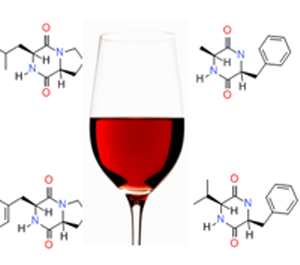Without sugars, wine production would not be possible. The sugars present in grapes in the form of glucose and fructose are converted by sugar fungi into ethyl alcohol and carbon dioxide. Grapes produce sucrose through leaf photosynthesis, which is converted (in fact, the sucrose molecules are hydrolysed (separated) by the enzyme invertase) into glucose and fructose during the ripening of the grapes.
In addition to glucose and fructose, there are other sugars in grapes, such as arabinose, rhamnose and xylose, which are still present in the wine after fermentation. These, together with part of the glucose and fructose that is not converted into alcohol after fermentation, are called ‘residual or unfermented sugars’. Thus, at the end of fermentation (which occurred naturally and not because the oenologist chose it or exogenous factors intervened), a dry wine may contain up to 4 grams per litre of unfermented sugars. The trio of alcohol, acidity, and sugar will determine a wine’s “harmonious” character.
The percentage of these components in a wine determines to a large extent the harmony of a wine’s taste and, to a lesser extent, its aromatic intensity (the same wine has stronger aromas if it is sweet and vice versa).
Many branded wines, intended for everyday consumption, are produced using the technology of blending wine with a certain amount of unfermented grape juice (must). This may be concentrated or rectified concentrated must also known as RCGM (Rectified Concentrated Grape Must). The use of sugar cane or beet sugar is not permitted, except for sparkling wines. In this way, dry, medium-dry or sweet wines may be produced from the same raw material.
If a sparkling wine has been sweetened with sucrose, this will not be present in the consumer’s glass because the acids will convert it into equal parts of glucose and fructose. If a must is sweetened with sucrose before fermentation begins, sucrose will be converted into glucose and fructose and then into alcohol by the action of the saccharomyces. Technically, there is no difference whether a must has been sweetened with concentrated must or sucrose: it is simply a matter of legislation and taste satisfaction.
Unfermented or residual sugars
The European Union has legislated on the content of unfermented sugars in wines and has defined the different categories as follows:
Dry wines: those having up to 4g/l or up to 9g/l of unfermented or residual sugars, if the difference between total acidity (expressed as tartaric acid) and unfermented sugars is not more than 2g/l (i.e. if the unfermented sugars are 9g/l, the acidity cannot be less than 7g/l, or if the total acidity is 5g/l, the unfermented sugars cannot exceed 7g/l for a wine to be considered dry.
Medium dry: those having up to 12g/l or up to 18g/l of unfermented or residual sugars, if the difference between total acidity and residual sugars is not more than 10g/l.
Medium sweet: those that exceed the limits of medium-dry wines but do not exceed 45g/l in unfermented sugars.
Sweet: Those with not less than 45g/l of unfermented or residual sugars.
Calories in wine come from two sources: alcohol and sugar. Wines from warm countries like ours always have a higher alcohol content than wines from other countries with different climates. Any wine may contain 120 to 300 calories in 150 ml of wine depending on its alcohol and unfermented sugar content. It is understood that the more alcohol a wine contains, the more calories it has and vice versa. The same applies to its unfermented sugar content.
By the same criteria, dry white and low-alcohol wines contain the fewest calories, followed by rosé, then red, then sweet wines, which usually have more calories due to their high content of unfermented sugars. As paradoxical as it may seem, some sweet wines contain fewer calories due to their low alcohol content.
For instance, a glass (150ml) of dry wine from the varieties of Maratheftiko, Cabernet Sauvignon or Shiraz may contain from 120 to 140 calories, while the same quantity of wine from the varieties of Spourtiko, Xynisteri, Chardonnay, Sauvignon Blanc from 118 to 122 calories and sparkling wines from 110 calories (Moscato d’Asti – due to its low alcohol content) to 124 calories (dry Champagne or Prosecco). Despite the higher alcohol content in red wines, these have several other advantages apart from containing Resveratrol and antioxidants. Recent research has shown that red wines also contain ellagic acid (which can also be found in strawberries, pomegranates, and raspberries), which inhibits fat growth in addition to its other health benefits.

